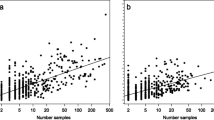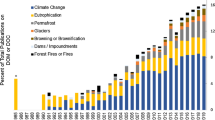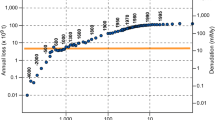Abstract
The impact of pre-Columbian subsistence agriculture on soil nutrient cycling in the American tropics is poorly quantified. Paleolimnological research can address this deficit by documenting the temporal evolution of nutrient cycling in lake watersheds over different time scales. Here we describe our use of a chemical sequential extraction technique adapted from soil fertility research to discern geochemical fractions of phosphorus (P) in lake sediments that serve as proxies for landscape-scale soil nutrient status. These P fractions are mineral P (the original lithic source of bioavailable P), occluded P (mainly bound to soil oxides), and organic P (remains of organic matter production by plants). We applied the P fractionation technique to a lake sediment core from a small lake in southern Costa Rica, Laguna Zoncho. Prior analyses of microfossils and stable carbon isotopes in this core documented an approximately 3,000 year history of human occupation and agricultural activity in the Zoncho watershed, and shifts in diatom communities in the lake associated both with human impacts and with climate-driven changes in lake level. Our P analyses revealed relatively constant P geochemistry during the first approximately 2,500 years of the record, when other sedimentary proxies reveal forest clearance and maize agriculture of varying intensity. However, the period from approximately 500 to 100 years BP is marked by a drastic shift toward a P geochemistry dominated by occluded forms, with a concomitant decrease in the relative content of both the organic and mineral P forms. This interval coincides with post-Conquest depopulation and forest regeneration at the site, and with an apparent deepening of the lake caused by a shift toward a wetter climate. The dominance of the occluded P fraction during this interval is the opposite of the trend expected with such a climate shift, implicating human dynamics as the principal driver of the changes in soil nutrient status indicated by the P fractions in the Zoncho core. We propose that the entire P geochemical record is dominated by human-induced alteration of the soil nutrient cycles via agriculture and occupation, and that the only interval that reveals the “natural” nutrient status in the region is the short interval when the site is abandoned and surrounding forests regrow. These results for Laguna Zoncho reveal the close connection between even relatively low-technology human activities and soil nutrient status.






Similar content being viewed by others
References
Anchukaitis KJ, Horn SP (2005) A 2000-year reconstruction of forest disturbance from southern Pacific Costa Rica. Paleogeogr Paleoclim Paleoecol 221:35–54
Antibus RK, Croxdale JG, Miller OK, Linkins AE (1981) Ecotomycorrhizal fungi of Salix rotundifolia. III. Resynthesized mycorrhizal complexes and their surface phosphatase activities. Canad J Bot 59:2458–2465
Behling H (2000) A 2, 680-year high-resolution pollen and charcoal from the Cordillera de Talamanca in Panama: a history of human and volcanic forest disturbance. The Holocene 10:387–393
Bradbury JP (1982) Holocene chronostratigraphy of Mexico and Central America. Striae 16:46–48
Brenner M, Rosenmeier MF, Hodell DA, Curtis JH (2002) Paleolimnology of the Maya Lowlands: long-term perspectives on interactions among climate, environment, and humans. Anc Mesoam 13:141–157
Chadwick OA, Derry LA, Vitousek PM, Huebert BJ, Hedin LO (1999) Changing sources of nutrients during four million years of ecosystem development. Nature 397:491–497
Chen CR, Condron LM, Xu ZH (2008) Impacts of grassland afforestation with coniferous tress on soil phosphorus dynamics and associated microbial processes: a review. For Ecol Manag 255:396–409
Clement RM, Horn SP (2001) Pre-Columbian land-use history of Costa Rica: a 3000-year record of forest clearance, agriculture and fires from Laguna Zoncho. The Holocene 11:419–426
Coen E (1983) Climate. In: Janzen DH (ed) Costa Rican natural history. University of Chicago Press, Chicago, pp 35–46
Colinvaux P, De Oliveria PE, Moreno PJE (1999) Amazon Pollen Manual and Atlas/Manual e Atlas Palinológico da Amazônia. Harwood Academic Publishers, Amsterdam
Crews TE, Kitayama K, Fownes JH, Riley RH, Herbert DA, Mueller-Dombois D, Vitousek PM (1995) Changes in soil phosphorus fractions and ecosystem dynamics across a long chronosequence in Hawaii. Ecology 76:1407–1424
Cross AF, Schlesinger WH (1995) A literature review and evaluation of the Hedley fractionation: applications to the biogeochemical cycle of soil phosphorus in natural ecosystems. Geoderma 64:197–214
Curtis JH, Hodell DA, Brenner M (1996) Climate variability on the Yucatan Peninsula (Mexico) during the past 3500 years, and the implications for Maya cultural evolution. Quat Res 46:37–47
Daily G, Ehrlich PR, Sanchez-Azofeifa GA (2001) Countryside biogeography: use of human-dominated habitats by avifauna of southern Costa Rica. Ecol Appl 11:1–13
Dearing JA, Hu Y, Doody P, James PA, Brauer A (2001) Preliminary reconstruction of sediment-source linkages for the past 6000 years at the Petit Lac d’Annecy, France based on mineral magnetic data. J Paleolimnol 25:245–258
Dearing JA, Jones RT, Shen J, Yang X, Boyle JF, Foster GC, Crook DS, Elvin MJD (2008) Using multiple archives to understand past and present climate-human–environment interactions: the lake Erhai catchment, Yunnan Province, China. J Paleolimnol 40:3–31
deMenocal P (2001) Cultural responses to climate change during the Late Holocene. Science 292:667–673
Denevan WM (1992) The pristine myth: the landscape of the Americas in 1492. Ann Assoc Am Geogr 82:369–389
Filippelli GM (2002) The global phosphorus cycle. Rev Min Geochem 48:391–425
Filippelli GM, Souch C (1999) Effects of climate and landscape development on the terrestrial phosphorus cycle. Geology 27:171–174
Filippelli GM, Sierro FJ, Flores JA, Vázquez A, Utrilla R, Pérez-Folgado M, Latimer J (2003) A sediment-nutrient-oxygen feedback responsible for productivity variations in late Miocene sapropel sequences of the western Mediterranean. Paleogeogr Paleoclim Paleoecol 190:335–348
Filippelli GM, Souch C, Menounos B, Slater-Atwater S, Jull TAJ, Slaymaker O (2006) Alpine lake records reveal the impact of climate and rapid climate change on the biogeochemical cycling of soil nutrients. Quat Res 66:158–166
Fritz SC, Metcalfe SE, Dean W (2001) Holocene climate patterns in the Americas inferred from paleolimnological records. In: Markgraf V (ed) Interhemispheric climate linkages. Academic Press, San Diego, pp 241–263
Froelich PN (1988) Kinetic control of dissolved phosphate in natural rivers and estuaries: a primer on the phosphate buffer mechanism. Limnol Oceanogr 33:649–668
Garcia-Montiel DC, Neill C, Melillo J, Thomas S, Steudler PA, Cerri CC (2000) Soil phosphorus transformations following forest clearing for pasture in the Brazilian Amazon. Soil Sci Soc Am J 64:1792–1804
Gardner LR (1990) The role of rock weathering in the phosphorus budget of terrestrial watersheds. Biogeoch 11:97–110
Gierlowski-Kordesch EH, Kelts KR (eds) (2000) Lake basins: through space and time. AAPG Studies in Geology, 46, Tulsa, OK, 648 pp
Gomez B, Filippelli G, Carter L, Trustrum N (2001) Recent sedimentation on an actively subsiding shelf: Hikurangi subduction margin, North Island, New Zealand. AGU Chapman Conference, Puerto Rico
Grimm EC, Lozano-García S, Behling H, Markgraf V (2001) Holocene vegetation and climate variability in the Americas. In: Markgraf V (ed) Interhemispheric climate linkages. Academic Press, San Diego, pp 325–370
Grossmann EB, Mladenoff DJ (2008) Farms, fires, and forestry: disturbance legacies in the soils of the Northwest Wisconsin (USA) Sand Plain. For Ecol Manag 256:827–836
Guthrie RD (2006) New carbon dates link climatic change with human colonization and Pleistocene extinctions. Nature 441:207–209
Haberyan KA, Horn SP (2005) Diatom paleoecology of Laguna Zoncho, Costa Rica. J Paleolimnol 33:361–369
Haberyan KA, Horn SP, Umaña G (2003) Basic limnology of fifty-one lakes in Costa Rica. Revista de Biología Tropical 51:107–122
Haug GH, Hughen KA, Sigman DM, Peterson LC, Rohl U (2001) Southward migration of the intertropical convergence zone through the Holocene. Science 293:1304–1307
Haug GH, Gunther D, Peterson LC, Sigman DM, Hughen KA, Aexhlimann B (2003) Climate and the collapse of Maya civilization. Science 299:1731–1735
Hodell DA, Curtis JH, Brenner M (1995) Possible role of climate in the collapse of Classic Maya civilization. Nature 375:391–394
Horn SP (1993) Postglacial vegetation and fire history in the Chirripó páramo of Costa Rica. Quat Res 40:107–116
Horn SP (2007) Late quaternary lake and swamp sediments: recorders of climate and environmental history. In: Bundschuh J, Alvarado GE (eds) Central America: geology, resources, hazards, vol 1. Taylor & Francis/Balkema, Leiden, pp 423–441
Jurinak JJ, Dudley LM, Allen MF, Knight WG (1986) The role of calcium oxalate in the availability of phosphorus in soils of semiarid regions: a thermodynamic study. Soil Sci 142:255–261
Kirch PV (2005) Archeology and global change: the Holocene record. Ann Rev Environ Resour 30:409–440
Lane CS, Horn SP, Mora CI (2004) Stable carbon isotope ratios in lake and swamp sediments as a proxy for prehistoric forest clearance and crop cultivation in the Neotropics. J Paleolimnol 32:375–381
Leyden BW (2002) Pollen evidence for climatic variability and cultural disturbance in the Maya Lowlands. Anc Mesoam 13:85–101
Malcolm RE (1983) Assessment of phosphatase activity in soils. Soil Biol Biochem 15:403–408
Northrop LA, Horn SP (1996) PreColumbian agriculture and forest disturbance in Costa Rica: palaeoecological evidence from two lowland rainforest lakes. The Holocene 6:289–299
O’Connor PJ (2005) Human impacts. Geochemical atlas of Europe, Part 1. In: Salminen R (ed) Geological Survey of Finland, Helsinki
Oldfield F (1977) Lakes and their drainage basins as units of sediment based ecological study. Prog Phys Geogr 3:460–504
Ruddiman WF (2003) The anthropogenic greenhouse era began thousands of years ago. Clim Change 61:261–293
Ruttenberg KC (1992) Development of a sequential extraction method for different forms of phosphorus in marine sediments. Limnol Oceanogr 37:1460–1482
Schlesinger WH (1997) Biogeochemistry: an analysis of global change. Academic Press, San Diego
Schlesinger WH, Bruijnzeel LA, Bush MB, Klein EM, Mace KA, Raikes JA, Whittaker RJ (1998) The biogeochemistry of phosphorus after the first century of soil development on Rakata Island, Krakatau, Indonesia. Biogeochem 40:37–55
Smol JP, Last WM (2003) The 100th issue of the Journal of Paleolimnology: reflections and future challenges. J Paleolimnol 29:137–139
Strickland JDH, Parsons TR (1975) A practical handbook of seawater analysis, fish. Res Board Can Bull 167: 311 pp
Tarafdar JC, Claasen N (1988) Organic phosphorus compounds as a phosphorus source for higher plants through the activity of phosphatase produced by plant roots and microorganisms. Biol Fertil Soils 5:308–312
Tiessen H, Moir JO (1993) Characterization of available P by sequential extraction. In: Carter M (ed) Soil sampling and methods of analysis. Lewis, Boca Raton, pp 75–86
Tiessen H, Stewart JWB, Cole CV (1984) Pathways of phosphorus transformations in soils of differing pedogenesis. Soil Sci Soc Amer J 48:853–858
Vitousek PM, Chadwick OA, Crews TE, Fownes JH, Hendricks DM, Herbert D (1997) Soil and ecosystem development across the Hawaiian Islands. GSA Today 7:1–8
Walker TW, Syers JK (1976) The fate of phosphorus during pedogenesis. Geoderma 15:1–19
Wilmshurst JM (1997) The impact of human settlement on vegetation and soil stability in Hawke’s Bay, New Zealand. New Zealand J Bot 35:97–111
Ziegler AD, Sutherland RA, Giambelluca TW (2001) Acceleration of Horton overland flow and erosion in an upland agricultural watershed in northern Thailand. Geomorphology 41:249–262
Acknowledgments
Support from this research came from the National Science Foundation (BCS-9911526 to GF and CS; OCE-0452428 to GF). We thank Jennifer Latimer and Sara Slater-Atwater for laboratory assistance. Sediment coring at Laguna Zoncho and prior radiocarbon and microfossil analyses were funded by a grant to S. Horn and R. L. Sanford, Jr., from The A. W. Mellon Foundation.
Author information
Authors and Affiliations
Corresponding author
Rights and permissions
About this article
Cite this article
Filippelli, G.M., Souch, C., Horn, S.P. et al. The pre-Colombian footprint on terrestrial nutrient cycling in Costa Rica: insights from phosphorus in a lake sediment record. J Paleolimnol 43, 843–856 (2010). https://doi.org/10.1007/s10933-009-9372-1
Received:
Accepted:
Published:
Issue Date:
DOI: https://doi.org/10.1007/s10933-009-9372-1




